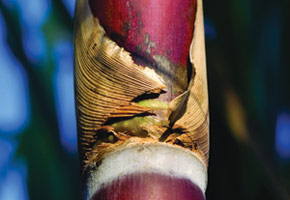

New statistical analysis methods and software facilitate understanding of the complex sugarcane genome
New statistical analysis methods and software facilitate understanding of the complex sugarcane genome.
New statistical analysis methods and software facilitate understanding of the complex sugarcane genome.

New statistical analysis methods and software facilitate understanding of the complex sugarcane genome
By Karina Toledo
Agência FAPESP – A new statistical analysis method and accompanying software developed at the Universidade de São Paulo (USP) are expected to facilitate studies on the sugarcane genome, paving the way for research that will improve the plant’s genetics. The results of the study were published in PLoS One.
Even though Brazil may be the global leader in sugarcane and bioethanol production, much research remains to be conducted. Currently, an average of 84 tons of cane is produced per hectare of the land planted in the country. Scientists estimate that with genetic improvement, it will be possible to raise that average to 380 tons.
However, the challenge is great, as explained by Antonio Augusto Franco Garcia, a researcher in the Genetics Department of the Luiz de Queiroz School of Agriculture (ESALQ/USP) and one of the authors of a study that is part of a Thematic Project, conducted through the FAPESP Bioenergy Research Project (BIOEN) and coordinated by Anete Pereira de Souza, a professor in the Universidade Estadual de Campinas Plant Biology Department.
“It is very difficult to develop studies on the genetics of sugarcane, given the complexity of its genome,” said Garcia.
Although human beings and nearly all animals are diploids (meaning they have only two copies of each chromosome), sugarcane can have up to twenty copies. This means that whereas each individual in the human species can have up to two different forms of each gene (one inherited from the father, and the other from the mother), the situation is much more complex in sugarcane, as any given gene could theoretically have many varying forms in the same individual.
“There are regions in the sugarcane genome with six chromosomal sets and others with 8, 10 or even 20 sets. For this reason, genetic knowledge on the species still is not very advanced,” explained Garcia.
The first step in solving the puzzle is to genotype the species. “Unlike sequencing, which analyzes the entire genome from a single or few individuals of the species, genotyping reads specific parts of the genome in many individuals of a given population,” Garcia said.
Then, for example, a genetic map can be generated by locating the regions of the chromosomes with the genes that regulate sugar production, resistance to diseases and other interesting characteristics.
“Only after this will it be possible to think about using genetic markers to perform assisted selection, something that is already achieved in bovine improvement, for example,” said Garcia. “The results we get from sugarcane will be a great help to similar studies in other polyploids that will also benefit from these new technologies.”
This is one of the Thematic’s objectives. With resources from the project, sophisticated genotyping equipment was purchased, and many students are finishing degrees. “We deposit the genetic material in the machine, and it measures the intensity of the alleles, giving the results with quantitative measures. This is used routinely with diploid species, but we did not have a way to classify the data in the case of sugarcane and other polyploids. The genetic principals and analysis models are different,” tells Garcia.
To solve the problem, the group developed a Bayesian method of analysis that was implemented with software called SuperMASSA. “This model allows us to include a great deal of available information, such as the genotype of the genitors and the expected segregations for the type of population studied,” Garcia explained.
Other participants in the study included Oliver Serang from Harvard University and Marcelo Mollinari, Garcia’s doctoral student and advisee and a FAPESP scholarship holder. The genotyping was performed by Thiago Marconi (from UNICAMP) under the supervision of Anete Souza and by a number of other collaborators from Brazil and abroad.
The SuperMASSA software is available for use at: http://statgen.esalq.usp.br/SuperMASSA. The tools developed can be used to study both the genetics of sugarcane and any polyploidy species. “From now on, we can focus on developing genetic maps by performing associative mapping and genome selection. Our group is already working on this, and we intend to publish a series of articles over the coming months,” said Garcia.
According to the researcher, groups from other nations are already conducting polyploid genotyping, but they use statistics adapted from the methods developed for diploids in their analyses. “They are inefficient methodologies, and the results are not as precise. We can now truly genotype polyploids. If Brazil had not invested in this technology, we would be out of step in studies on a plant as important as sugarcane,” Garcia said.
Republish
The Agency FAPESP licenses news via Creative Commons (CC-BY-NC-ND) so that they can be republished free of charge and in a simple way by other digital or printed vehicles. Agência FAPESP must be credited as the source of the content being republished and the name of the reporter (if any) must be attributed. Using the HMTL button below allows compliance with these rules, detailed in Digital Republishing Policy FAPESP.





